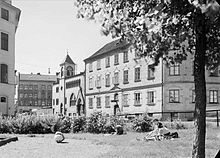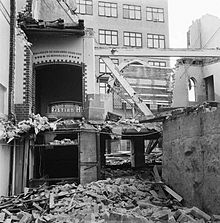Fatherland småkirke
The Vaterland småkirke ( German “Vaterland-Kleinkirche” ), also known as Vaterland kirke ( German “Vaterland-Kirche” ), was a small church in the Vaterland district of Oslo , Norway .
description
The fatherland småkirke was Oslo's first småkirke, as the small churches built directly as street buildings in Norway are called. The Vaterland kirke was subordinate to the parish ( Norwegian Sogn ) of the neighboring Jakob kirke in Oslo. The church building was in a neighborhood with many winding streets and a lot of poverty and social problems.
The address was initially Søberggangen 1, after more streets had been built in the Vaterland district, Vognmannsgata 25 . There were 300 seats in the church. The interior of the nave was connected to the sacristy , which could be separated by sliding doors.
The building was constructed with an attached parish hall and a parish apartment. The Fatherland Church was built in plastered brickwork with decorative elements made of red brick . The church building was designed in the neo-Romanesque style and provided with some neo-Gothic style elements. It had an asymmetrical main facade, with the church tower being the natural center. On the street side there was a large main portal and a number of smaller arched windows below the cornice and a large leaded glass window in the nave . Inside the church was an altarpiece by Emanuel Vigeland in the form of a wall painting.
history
In the Oslo district of Vaterland, the population grew steadily towards the end of the 19th century, and the high population density was accompanied by social problems. Fatherland fell into disrepute as a district with many pubs, entertainment venues and brothels as well as a place of organized crime and the underworld. Demands for a church to be built in the area were finally heard by the Lutheran diocese of Oslo in the late 1890s . The diocese acquired a corresponding piece of land and commissioned the building of the church.
The Vaterland Church was built according to the plans of the German-born architect Heinrich Jürgensen and completed in 1899. On December 22nd, 1899, the church was consecrated by Oslo Bishop Anton Christian Bang . The Fatherland Church has been open to the public for the whole week since its consecration.
The focus of the Fatherland parish was not only in the preaching of the Word of God and in church services, but also concentrated on the social problems of the local fatherlands. In the basement a conference room was set up for scout groups, among other things.
An asylum for homeless men was set up in the parish hall of the Fatherland Church in 1917, which was organized by parishioners Sara Floch and Anna Jensen. In 1917 the parish of the Vaterlandkiche established a kindergarten in a neighboring farm with the support of the Norwegian State Church , and later an old people's home for single women.
The church was extensively renovated in 1949 on the occasion of the anniversary of the last bishops' visit 50 years ago. In the 1950s, when the Vaterland district began to be renovated and rebuilt as part of a district renewal, the plan arose to demolish the entire street, including the church. The square should create space for the extension of the Oslo tunnel line and new urban development.
The church and the neighboring houses were finally demolished in 1959 after initial resistance. The Hotel Oslo Plaza and the Oslo Spektrum are located in the immediate vicinity of the former location .
The parish of the fatherland småkirke was integrated into the parish of the neighboring Grønland kirke and in 2013 merged with the Gamlebyen kirke (Old Town Church) under the name Gamlebyen-Grønland .
Cultural monument
The fatherland småkirke has been registered as a cultural monument by the Riksantikvaren (Reich archivist) under number 85781 .
literature
- Ludwig Schübeler: Småkirken i Fatherland: Jubileumsskrift til kirkens 35-årsdag . 52 p., Oslo 1934
- MC Kirkebøe: Oslos kirker i gammel og ny tid , new edition by KA Tvedt and Ø. Reisegg; Kunnskapsforlaget , Oslo 2007, pp. 16-17.
Web links
- Fatherland småkirke on artemisia.no
- Fatherland småkirke in Oslo byleksikon , 3rd edition 1987.
- Fatherland småkirke on norske-kirkebygg.origo.no
Individual evidence
- ↑ 85781 i Riksantikvarens culture mines base.
Coordinates: 59 ° 54 ′ 47.3 " N , 10 ° 45 ′ 22.5" E



